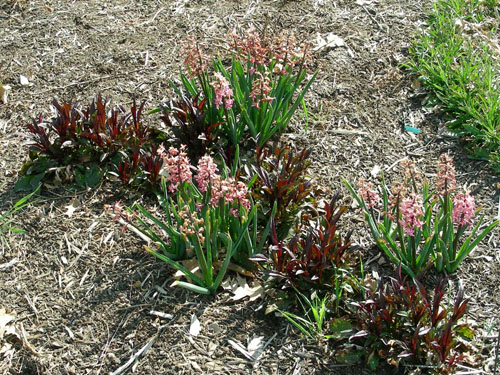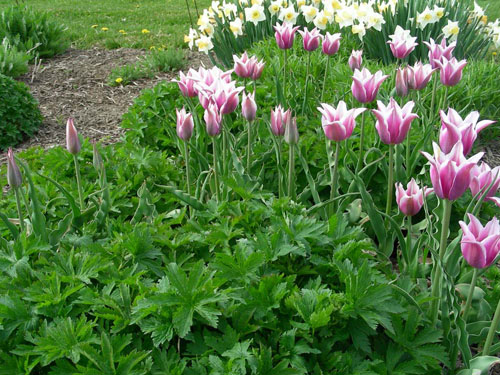 |
Bulbs and perennials can be a lot like brothers and
sisters.
You love them both but they don’t always play well together.
Spring bulbs always insist on going to the head of the line and can stifle the younger, impressionable plants. Perennials, on the other hand, are quick to throw a tantrum when they are stuck with the ugly, dying foliage that bulbs leave behind. What’s
a gardener to do?
 There's lots of information out there about
combining either bulbs or perennials. Mixing the two together, however, not
so much.
There's lots of information out there about
combining either bulbs or perennials. Mixing the two together, however, not
so much.
I’m especially interested in the topic because I need to
revamp several of my garden beds this fall. That's partly due to the drought, but also
because my tulips are close to the end of their useful lives.
With bulbs due in the stores any day now and catalogs already in my mailbox, I decided it was time to re-examine the way I use them with perennials.
In the past, I've had mixed results combining daffodils and daylilies. I've also occasionally planted bulbs near hostas and ferns. Both of these latter two plants, though, require shade which is a rare commodity in my young garden.
There must be
a better way.
Much of the information I found was extremely general, suggesting that you plant bulbs behind perennials that will emerge later. That unfortunately doesn't always work. Often, the perennial partner is either too fast or too slow, too early or too late. The combination pictured at the top -- pink tulips with Early Bird catmint (Nepeta 'Early Bird') in front and Little Grapette' daylily (Hemerocallis 'Little Grapette') at right -- is one that doesn't quite work in my garden for those reasons. The National Gardening Association has a few suggestions. You're out of luck though if your bulb aspirations go beyond flowering onions (Allium), spider lily (Lycoris) or purple and lavender tulips.
The National Gardening Association has a few suggestions. You're out of luck though if your bulb aspirations go beyond flowering onions (Allium), spider lily (Lycoris) or purple and lavender tulips.
The late, great British plantsman Christopher Lloyd, in his book Succession
Planting for Year-Round Pleasure, had many suggestions in a chapter devoted to perennials and bulbs
that share the same space.
"You need to consider the habit and vigour of both the protagonist and its partner(s)," he wrote."What you must never use in any part of a mixed border are broad-leaved daffodils, but I constantly see this mistake being made. They are far too aggressive...."
One of his combinations that lasts for several months: Narcissus ‘Dove Wings,’ a Triandrus type of daffodil, plus Hemerocallis ‘Marion Vaughn’ and Phlox paniculata.
Alas, many of the plants he mentioned won't grow in my Zone 5 garden. He did, however, pair bulbs with plants that bloom later in the season. I especially think that his suggestion of Allium cristophii and Japanese anemones would work well.
One of his combinations that lasts for several months: Narcissus ‘Dove Wings,’ a Triandrus type of daffodil, plus Hemerocallis ‘Marion Vaughn’ and Phlox paniculata.
Alas, many of the plants he mentioned won't grow in my Zone 5 garden. He did, however, pair bulbs with plants that bloom later in the season. I especially think that his suggestion of Allium cristophii and Japanese anemones would work well.
Online, there are some other interesting combinations on an industry-sponsored Website, www.digdropdone.com. (Just ignore the female stereotypes, which garnered a lot of criticism when the site went live last spring.)
About a third of its suggested pairings, though, can also be found on a more extensive site, www.hort.cornell.edu/combos. That site includes a number of mixtures tested by the Cornell University's Department of Horticulture. It includes pictures of each combination in various stages of growth.
 |
| Hyacinth 'Jan Bos' with Penstemon 'Husker Red' Photo used with permission of Cornell University Department of Horticulture |
Suggested pairings cover tulips, narcissus, crocus and miscellaneous bulbs. I especially like the combination of Hyacinth ‘Jan Bos’ with Penstemon ‘Husker Red.” The red foliage of the Penstemon complements the flowers nicely.
 |
| Tulip Ballade with Geranium 'Mayflower' Photo used with permission of Cornell University Department of Horticulture |
In any event, I still have plenty of time to do some planning. The drought is still hanging on and the ground temperature has a long way to go until it falls to the 55-degree mark preferred for bulb planting.
My goal is a simple one: peace in the garden next spring, with everything working together like one big, happy -- and beautiful -- family.
By Karen Geisler
My goal is a simple one: peace in the garden next spring, with everything working together like one big, happy -- and beautiful -- family.
By Karen Geisler











